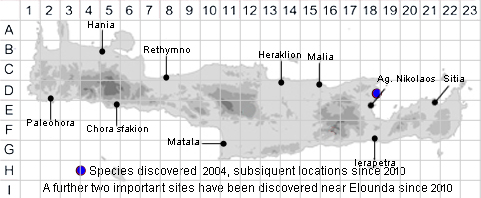
SPECIES DESCRIPTION
BELLEVALIA JULIANA
Family and Genus:- See- HYACINTHACEAE
Common Names:- None
Homotypic Synonyms:- - None
Meaning:- Bellevalia (L) For P. R. De Belleval (1558-1632) early systematist.
Juliana (L) For Julia Jones FLS. Founder and president of the
organization “Flowers of Crete”
General description:- Perennial bulbous plant.
Bulb:-
1) Ovoid, 2.4-2.8 x 3-3.5cm, with brown tunics.
Scape:-
1) 1 or 2, greenish, tinged with violet in the upper part, 25-35 cm tall.
Leaves:-
1) 2 or 3, green, 28-50 x 1.2-3 (24) cm, long linear-lanceolate, shallowly
canaliculate, longer than the scape, margins slightly undulate, ciliate.
Flowers:-
1) Raceme, cylindrical, with 22-39 flowers, 5-9.5 cm long at anthesis, elongating to
15.5 cm in fruit.
2) Bracts, 1-1.5(-2) mm long. white or light pink, triangular.
3) Pedicels, erecto-patent before anthesis, ± patent at anthesis, violet, 5-11 mm
elongating to 16 mm in fruit.
4) Perianth, 9-11 mm long, tubular, usually brown at the base, white in the distal
part with green veins.
5) Perianth lobes, suberect or slightly recurved terminally, with green stripes, ovate
to oblong, 3-3.5 mm long, apex triangular to acuminate.
6) Stamens, shorter than the perianth.
7) Anthers, dark purple-violet to blue-violet, 1.2-1.8 mm long.
8) Filaments, attached just below the base of the perianth lobes, white, narrowly
triangular to linear, 2-3 mm long.
Fruit:-
1) Capsule, orbicular, triquetrous, 7- 9 mm in diam.
2) Seeds, subglobose, 1-2.2 mm diam.
Habitat:- Rocky limestone hillsides on abandoned cultivation terraces. 0-100 m.
Distribution:- Endemic to east Crete originally known from only one location. two
further locations found by Steve Lenton in 2010. Very rare.
Flowering time:- Feb-Mar.
Photos by:- Steve Lenton
Status :-
Vulnerable (VU), according to the IUCN 2012, meeting criteria B1ab(iii,v) +2ab
(iii,v); D2.
